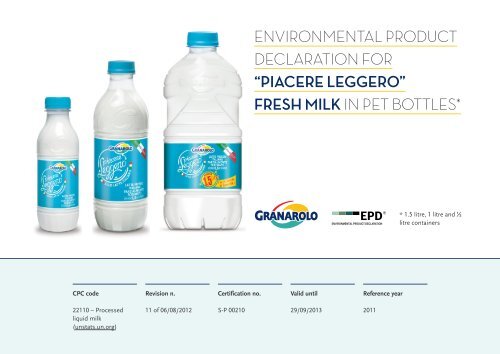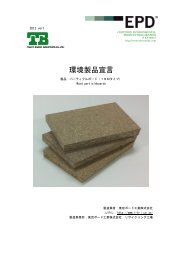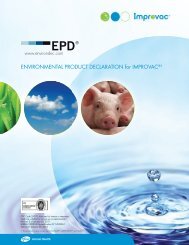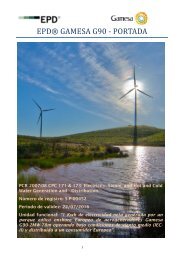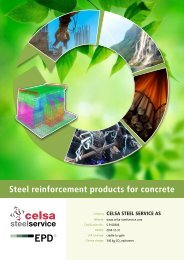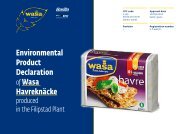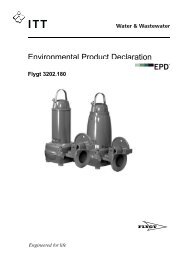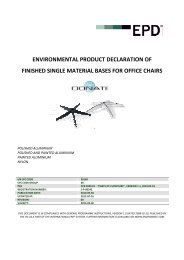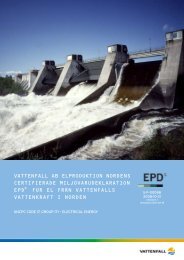EPD Fresh milk - The International EPD® System
EPD Fresh milk - The International EPD® System
EPD Fresh milk - The International EPD® System
You also want an ePaper? Increase the reach of your titles
YUMPU automatically turns print PDFs into web optimized ePapers that Google loves.
ENVIRONMENTAL PRODUCT<br />
DECLARATION FOR<br />
“PIACERE LEGGERO”<br />
FRESH MILK IN PET BOTTLES*<br />
* 1.5 litre, 1 litre and ½<br />
litre containers<br />
CPC code<br />
Revision n.<br />
Certification no.<br />
Valid until<br />
Reference year<br />
22110 – Processed<br />
liquid <strong>milk</strong><br />
(unstats.un.org)<br />
11 of 06/08/2012<br />
S-P 00210<br />
29/09/2013<br />
2011
Epd FOR “PIACERE LEGGERO” FRESH MILK IN PET BOTTLES<br />
1. the company<br />
1. the company<br />
2. certification<br />
<strong>The</strong> company was set up in 1957 by a small cooperative<br />
situated near Bologna and owned by Granlatte Società<br />
Cooperativa Agricola, together with which it forms the largest<br />
<strong>milk</strong> chain in Italy, with shares held directly by the farmer<br />
members of the cooperative.<br />
Since the early nineties, the Group has been divided into<br />
two distinct, synergistic structures: a consortium of <strong>milk</strong><br />
producers (Granlatte) – which operates in the farming industry<br />
and collects the raw material – and a joint-stock company<br />
(Granarolo S.p.A.), which controls the industrial and marketing<br />
activities.<br />
Granarolo is one of the leading food-processing companies in<br />
Italy. <strong>The</strong> Group closed the year 2011 with a turnover of about<br />
849 million euros and has:<br />
• 6 production plants distributed across the country;<br />
• 2,083 employees;<br />
• 1,200 refrigerated vehicles for the distribution.<br />
<strong>The</strong> group’s business is divided into 3 main areas: <strong>milk</strong> &<br />
cream, yogurt and dairy products.<br />
Granarolo is the leading Italian company in the sale of fresh<br />
<strong>milk</strong> and organic <strong>milk</strong> and dairy products under an industrial<br />
brand name and is one of the leaders on the market for UHT<br />
<strong>milk</strong> (2nd largest market share), yogurt (3rd) and fresh cheese<br />
(2nd).<br />
<strong>The</strong> central office of Granarolo S.p.A. is situated in Bologna<br />
and it has production plants in several regions of Italy.<br />
2. certification<br />
Granarolo adopts an integrated approach to quality policies<br />
that combines economic, environmental and ethical objectives<br />
along the entire food chain, from the farm to the consumer’s<br />
table.<br />
A path upon which the Company embarked about 15 years<br />
ago, by opting for a high quality strategy that has culminated<br />
today in the traceability of the chain, in the quality, in the<br />
environment and occupational safety.<br />
page 2
Epd FOR “PIACERE LEGGERO” FRESH MILK IN PET BOTTLES<br />
3. the product<br />
This Environmental Product Declaration <strong>EPD</strong> concerns<br />
the “Piacere Leggero” partly skimmed pasteurized fresh <strong>milk</strong><br />
packaged in one and a half-litre, one-litre and half-litre PET<br />
bottles. <strong>The</strong> “Piacere Leggero” pasteurized fresh <strong>milk</strong> in bottles<br />
solely comes from Italian selected farms and contains only<br />
1,6% of fat.<br />
<strong>The</strong> whole raw <strong>milk</strong> coming from the Granarolo production<br />
plants is subjected to a single pasteurization treatment and<br />
conforms to all the requirements laid down by law 169/89.<br />
<strong>The</strong> standards currently adopted by Granarolo for the raw<br />
material used enable the <strong>milk</strong> to be subjected to a more delicate<br />
pasteurization process so as to make it more similar to <strong>milk</strong><br />
freshly <strong>milk</strong>ed and, in addition, the <strong>milk</strong> is completely safe from<br />
the point of view of health and hygiene.<br />
3. the product<br />
traced <strong>milk</strong><br />
parameters<br />
weighted<br />
mean<br />
geometrical<br />
mean<br />
law<br />
standard<br />
Energy<br />
199 kJ (47 kcal)<br />
Fat p/v 3.85% – –<br />
Protein p/v 3.44% – –<br />
Protein<br />
3.24 g<br />
Somatic cells (thousands<br />
of cells per ml)<br />
Bacterial load (thousands<br />
of bacteria per ml)<br />
normal <strong>milk</strong><br />
parameters<br />
– 286 –<br />
– 28 –<br />
weighted<br />
mean<br />
geometrical<br />
mean<br />
law<br />
standard<br />
Fat p/v 3.82% – –<br />
Carbohydrates<br />
Fat<br />
Food fiber<br />
5.00 g of which sugar 5.00 g<br />
1.60 g of which saturated 1.10 g<br />
0.0 g<br />
Protein p/v 3.42% – –<br />
Somatic cells (thousands<br />
of cells per ml)<br />
Bacterial load (thousands<br />
of bacteria per ml)<br />
– 329 –<br />
– 80 –<br />
Sodium<br />
Calcium<br />
0.05 g<br />
120 mg (15% of the recommended daily intake)<br />
table 1 – quality and safety standards of raw material granarolo.<br />
table 2 - nutritional data per 100 ml of product.<br />
page 3
Epd FOR “PIACERE LEGGERO” FRESH MILK IN PET BOTTLES<br />
4. <strong>The</strong> Production Process<br />
<strong>The</strong> production process can be divided into the following four<br />
main phases:<br />
• production and collecting of raw <strong>milk</strong> at the cowsheds and<br />
transport to the plants;<br />
• production of containers;<br />
• industrial <strong>milk</strong> pasteurization and packaging process (Figure<br />
1);<br />
• transport to the distribution platforms (afterwards the <strong>milk</strong><br />
can be distributed to sales points or sent to Transit Point<br />
where the pre-ordered products assembly takes place).<br />
4. <strong>The</strong> Production<br />
Process<br />
pieve emanuele (mi)<br />
2011 total hq <strong>milk</strong> in 1.5 l pet – 661.302 liters<br />
bologna<br />
70%<br />
Assolac<br />
1.5<br />
liter<br />
30%<br />
Bologna<br />
pasturago (mi)<br />
1 liter<br />
bologna<br />
1 - 1.5 liter<br />
roma<br />
anzio (rm)<br />
1 liter<br />
nola (na)<br />
gioia del colle (ba)<br />
0.5 - 1 liter<br />
gioia del colle (ba)<br />
castrovillari (cs)<br />
2011 total hq <strong>milk</strong> in 1 l pet – 48.134.532 liters<br />
28.3%<br />
Bologna<br />
15.7%<br />
Pasturago<br />
1<br />
liter<br />
2011 total hq <strong>milk</strong> in 0.5 l pet – 2.065.133 liters<br />
11.7%<br />
Assolac<br />
13.5%<br />
Gioia del Colle<br />
30.8%<br />
Anzio<br />
r Production plant<br />
r Logistics platform<br />
castrovillari (cs)<br />
1 - 1.5 liter<br />
100%<br />
Gioia del Colle<br />
0.5<br />
liter<br />
figure 1 –granarolo plants where in 2011 the “piacere leggero” <strong>milk</strong> packaged in 1.5, 1 and 0.5 liter pet bottles was produced.<br />
page 4
Epd FOR “PIACERE LEGGERO” FRESH MILK IN PET BOTTLES<br />
Before being unloaded, the <strong>milk</strong> received is subjected to<br />
an initial incoming test to make sure that it is suitable for<br />
processing. After the refrigerated storage phase (at about 4°C),<br />
the <strong>milk</strong> is transferred to the pasteurization process, which<br />
consists of a continuous flow heat treatment at a temperature<br />
of 76°C for 21” (Figure 2).<br />
<strong>The</strong> phase after the pasteurization process consists in<br />
packaging the <strong>milk</strong> (Figure 3).<br />
<strong>The</strong> process starts with the transformation of the preforms<br />
into bottles, which are transferred to the filling machine and<br />
then labelled and grouped into bundles located on pallets.<br />
<strong>The</strong> so packaged <strong>milk</strong> is then transferred to the distribution<br />
from where it will be distributed directly to the points of sale<br />
or via the Transit Points where the pre-ordered products are<br />
assembled.<br />
4. <strong>The</strong> Production<br />
Process<br />
arrival of raw <strong>milk</strong><br />
packaging<br />
production<br />
of preform<br />
Stretch-blow mounding<br />
pasteurized<br />
<strong>milk</strong><br />
Cooling<br />
Cooling<br />
Packaging<br />
Storage in silo<br />
Pasteurization<br />
(76°C for 21 seconds)<br />
Labelling<br />
Packaging with heat shrink film<br />
Warming up<br />
Bacteria<br />
removal<br />
Titration<br />
Homogenization<br />
Pallettizing and winding<br />
Storage in refrigerator<br />
Degassing<br />
Skimming<br />
shipment<br />
figure 2 – diagram of the “piacere leggero” <strong>milk</strong> pasteurization process.<br />
figure 3 – the packaging of <strong>milk</strong> in pet bottles.<br />
page 5
Epd FOR “PIACERE LEGGERO” FRESH MILK IN PET BOTTLES<br />
5. Method Used<br />
<strong>The</strong> environmental performance of the product was quantified<br />
as laid down in the general rules of the <strong>EPD</strong> Program 1 and in<br />
the specifications of the group of products “Product Category<br />
Rules PCR 2010:12 “Processed liquid Milk” – CPC 2211”, using<br />
the LCA (Life Cycle Assessment) method regulated by the<br />
ISO 14040 series international standards, which are used to<br />
determine environmental impacts in terms of consumption of<br />
resources and atmospheric emissions of a product or service<br />
throughout its life (“from cradle to grave”).<br />
In this specific case, the LCA analysis was developed using<br />
some LCA databases as a further support tool, such as<br />
Ecoinvent, PlasticsEurope, LCA Food (within the software<br />
SimaPro v.7.3.3) and the Boustead Model 2 ; the contribution of<br />
generic data to the end results was less than 10%.<br />
<strong>The</strong> study was conducted on direct suppliers-producers,<br />
who were sent detailed questionnaires to ensure a complete<br />
characterization of their production activity.<br />
<strong>The</strong> data referred to the following periods:<br />
• 2011 for the processes, all production and transport<br />
procedures that take place at the plants in Bologna, Anzio,<br />
Gioia del Colle, Pasturago and Assolac-Castrovillari;<br />
• 2011 for the PET bottle preforms and the PE caps<br />
manufacturers.<br />
As regards the primary farming production and <strong>milk</strong> production<br />
cowsheds, the data refers to 10 sample cowsheds (7 situated in<br />
Northern Italy and 3 in Southern Italy).<br />
<strong>The</strong> functional unit to which the results apply is: 1 Litre of<br />
Granarolo “Piacere Leggero” Milk packaged in PET bottles (1.5<br />
litres, 1-litre and ½-litre bottles).<br />
1<br />
international epd® system managed by the international epd consortium<br />
- iec (www.environdec.com).<br />
2<br />
www.boustead-consulting.co.uk<br />
5. Method Used<br />
page 6
Epd FOR “PIACERE LEGGERO” FRESH MILK IN PET BOTTLES<br />
6. <strong>System</strong> Limits and Main Hypotheses<br />
<strong>The</strong> limits of the system studied include the entire High Quality<br />
Milk production process handled by Granarolo and, to be more<br />
precise, the production of <strong>milk</strong> at the farms, the pasteurization<br />
and packaging at the Granarolo Group and Assolac Castrovillari<br />
plants, the transport to the preliminary storage platforms and<br />
then to the Transit Points.<br />
A detailed diagram of the system analysed is shown in Figure<br />
4, which illustrates three different levels or subsystems for the<br />
following production activities:<br />
Upstream processes<br />
• “farms” raw <strong>milk</strong> production at the cowsheds;<br />
• “production of packaging materials” production of the PET<br />
preforms, of the packaging indicated on the bill of materials of<br />
the bottled Piacere Leggero <strong>milk</strong> and of the auxiliary materials<br />
for the pasteurization process.<br />
Core processes<br />
• “Granarolo process” <strong>milk</strong> pasteurization and packaging<br />
activities.<br />
Downstream processes<br />
• “transport of finished product” the transport of the PETpackaged<br />
Piacere Leggero <strong>milk</strong> to the distribution platforms<br />
and the transit points.<br />
6. <strong>System</strong> Limits and<br />
Main Hypotheses<br />
upstream processes<br />
core processes<br />
downstream processes<br />
production<br />
of raw <strong>milk</strong><br />
production<br />
of packaging<br />
output input<br />
Cattle, Feed, Water,<br />
Detergents, Energy consumption<br />
Farms<br />
Manure, Waste,<br />
Enteric fermentation emissions<br />
Raw<br />
materials<br />
energy ↓<br />
Production<br />
of Caps-PET<br />
preforms<br />
transport<br />
of raw <strong>milk</strong><br />
transport<br />
of containers<br />
treatment process<br />
water ↓<br />
energy ↓<br />
energy ↓<br />
Pasteurization<br />
Packaging<br />
Plants: Bologna, Anzio,<br />
Gioia del Colle (Sail), Pasturago,<br />
Castrovillari (Assolac)<br />
transport of finished product<br />
transport<br />
voluntary optional phases<br />
Transport to<br />
logistical platforms<br />
Use<br />
End of life<br />
of primary packages<br />
figure 4 – diagram of granarolo “piacere leggero” <strong>milk</strong> production system.<br />
page 7
Epd FOR “PIACERE LEGGERO” FRESH MILK IN PET BOTTLES<br />
7. Environmental Performance<br />
In accordance with the rules of the <strong>EPD</strong> system, below<br />
are shown the environmental performances referred per<br />
litre of <strong>milk</strong>. As the <strong>milk</strong> is distributed in 1.5, 1 and 0.5 litres<br />
containers, the results will be presented in such a way as<br />
to compare the impacts associated with the use of the two<br />
containers, keeping the functional unit fixed (i.e, the results of<br />
the half-litre container are simply twice those of the impacts of<br />
the one-litre container).<br />
Resources consumption<br />
<strong>The</strong> need for resources is indicated in two separate sections:<br />
renewable resources (Table 3) non-renewable resources (Table<br />
4) and water consumption (Table 5).<br />
upstream core downstream<br />
1.5 litre<br />
container<br />
renewable resources<br />
farms packaging other auxiliary<br />
materials<br />
Granarolo<br />
process<br />
transport<br />
of platforms<br />
total<br />
7. Environmental<br />
Performance<br />
hydroelectric 0.04 0.04 0.03 0.06
Epd FOR “PIACERE LEGGERO” FRESH MILK IN PET BOTTLES<br />
upstream core downstream<br />
1 litre<br />
container<br />
total<br />
renewable resources<br />
farms packaging other auxiliary<br />
materials<br />
Granarolo<br />
process<br />
transport<br />
of platforms<br />
energy<br />
resources<br />
(mj/l)<br />
hydroelectric 0.04 0.04 0.01 0.11
Epd FOR “PIACERE LEGGERO” FRESH MILK IN PET BOTTLES<br />
1.5 litre<br />
container<br />
non-renewable resources<br />
upstream core downstream<br />
total<br />
material resources (g/l)<br />
sodium chloride 17.51 0.09 3.91 0.01
Epd FOR “PIACERE LEGGERO” FRESH MILK IN PET BOTTLES<br />
1 litre<br />
container<br />
non-renewable resources<br />
upstream core downstream<br />
total<br />
material resources (g/l)<br />
sodium chloride 17.25 0.11 1.29 0.01
Epd FOR “PIACERE LEGGERO” FRESH MILK IN PET BOTTLES<br />
½ litre<br />
container<br />
non-renewable resources<br />
upstream core downstream<br />
total<br />
sodium chloride 17.06 0.14 2.01 0.01
Epd FOR “PIACERE LEGGERO” FRESH MILK IN PET BOTTLES<br />
upstream core downstream<br />
1.5 litre<br />
container<br />
total<br />
non-renewable resources<br />
farms packaging other auxiliary<br />
materials<br />
Granarolo<br />
process<br />
transport<br />
to platforms<br />
water consumption (l/l) 5.54 0.32 0.22 8.70 0.07 14.85<br />
upstream core downstream<br />
1 litre<br />
container<br />
total<br />
non-renewable resources<br />
farms packaging other auxiliary<br />
materials<br />
Granarolo<br />
process<br />
transport<br />
to platforms<br />
7. Environmental<br />
Performance<br />
water consumption (l/l) 5.46 0.39 0.09 4.69 0.02 10.65<br />
upstream core downstream<br />
½ litre<br />
container<br />
total<br />
non-renewable resources<br />
farms packaging other auxiliary<br />
materials<br />
Granarolo<br />
process<br />
transport<br />
to platforms<br />
water consumption (l/l) 5.40 0.53 0.25 3.25 0.03 9.46<br />
table 5 – total water consumption. data expressed in litres per litre of <strong>milk</strong> (1.5, 1 and ½ litre containers).<br />
page 13
Epd FOR “PIACERE LEGGERO” FRESH MILK IN PET BOTTLES<br />
Production of waste<br />
Another important data item in the description of the<br />
environmental impacts of the system is the production of<br />
waste. Table 6 shows the total amount of waste produced in<br />
order to produce one litre of “Piacere Leggero” <strong>milk</strong>.<br />
1.5 litre<br />
container<br />
upstream core downstream<br />
total<br />
production of waste<br />
non-hazardous waste (g/l) 0.98 3.41 0.08 24.26
Epd FOR “PIACERE LEGGERO” FRESH MILK IN PET BOTTLES<br />
Emissions into the air and water<br />
With regard to the emission of pollutants, the <strong>EPD</strong><br />
<strong>International</strong> <strong>System</strong> lays down that they must be presented<br />
in “aggregate” form, assessing them through indicators that<br />
refer to different types of environmental impact expressed in<br />
terms of appropriate equivalent substances 9 on the basis of the<br />
criteria and specifications present in the system rules.<br />
<strong>The</strong> results of this classification are given in Table 7 below in<br />
which the values refer to one litre of “Piacere Leggero” <strong>milk</strong>.<br />
9<br />
the phases of an lca classification and characterization study entail<br />
identifying a series of potential environmental effects and then<br />
determining which of the impacts identified during the inventory phase<br />
contributes to a given effect (classification). for example, co 2<br />
, co and<br />
hydrocarbons all contribute to the greenhouse effect. another aim of<br />
this phase is to assign a numeric value to the degree to which the process<br />
examined contributes to the potential impacts identified by determining<br />
given environmental indicators (characterization) expressed in quantities<br />
of suitable equivalent substances.<br />
upstream core downstream<br />
1.5 litre<br />
container<br />
non-renewable resources<br />
global warming potential -<br />
(GWP) (g CO 2<br />
eq)<br />
farms packaging other auxiliary<br />
materials<br />
Granarolo<br />
process<br />
transport<br />
to platforms<br />
total<br />
921.26 10 126.29 24.77 129.13 57.90 1,259.35<br />
7. Environmental<br />
Performance<br />
impact indicator<br />
acidifcation - AP<br />
(g SO 2<br />
eq)<br />
eutrophication - EP<br />
(g PO 43<br />
- eq)<br />
ozone depletion - ODP<br />
(g CFC-11 eq)<br />
17.63 0.50 0.12 0.23 0.27 18.75<br />
6.16 0.06 0.03 0.06 0.06 6.38<br />
Epd FOR “PIACERE LEGGERO” FRESH MILK IN PET BOTTLES<br />
impact indicator<br />
1 litre<br />
container<br />
non renewable resources<br />
upstream core downstream<br />
total<br />
global warming potential - (GWP)<br />
(g CO 2<br />
eq)<br />
907.42 11 136.48 11.90 125.58 15.03 1,196.40<br />
acidifcation - AP<br />
(g SO 2<br />
eq)<br />
17.37 0.53 0.06 0.37 0.07 18.40<br />
eutrophication - EP<br />
(g PO 43<br />
- eq)<br />
6.07 0.07 0.01 0.09 0.02 6.26<br />
ozone depletion - ODP<br />
(g CFC-11 eq)<br />
Epd FOR “PIACERE LEGGERO” FRESH MILK IN PET BOTTLES<br />
8. Additional Information<br />
Representativeness of the farms<br />
Granarolo acquires the raw material from a large number of<br />
farms, all situated in Italy, which are divided into classes, not<br />
only on the basis of the number of animals but also in terms of<br />
the quantity of <strong>milk</strong> produced per day (expressed in litres/day).<br />
<strong>The</strong> distribution of <strong>milk</strong> producers according to the distinction<br />
made by Granarolo is illustrated in Figure 5, from which it<br />
emerges that most of the <strong>milk</strong> (about 81%) comes from the<br />
cowsheds with a daily production of over 3,000 litres/day.<br />
contributions to total <strong>milk</strong> production by cowshed categories<br />
81%<br />
>3,000 l/g<br />
figure 5 – contributions to total <strong>milk</strong> production by the cowshed<br />
categories (2011 data).<br />
2.6%<br />
501-1,000 l/g<br />
0.8%<br />
0-500 l/g<br />
15.6%<br />
1,001-3,000 l/g<br />
Primary <strong>milk</strong> production data<br />
<strong>The</strong> primary <strong>milk</strong> production data used for the LCA and to draw<br />
up this Environmental Product Declaration refers to a sample<br />
of 8 farms; in quantitative terms, the production of these<br />
companies was equivalent to 12% of the Piacere Leggero <strong>milk</strong><br />
produced by Granarolo in 2011.<br />
As regards their production, the sample cowsheds belong<br />
to the main categories shown in Figure 5 (> 300 l/g), so as to<br />
guarantee that 99,8% of the Piacere Leggero <strong>milk</strong> produced<br />
and delivered to Granarolo is represented (the cowsheds with a<br />
productivity of less than 300 litres/day, which account for 0,2%<br />
of the <strong>milk</strong> were left out of the sample).<br />
Primary <strong>milk</strong> processing data<br />
<strong>The</strong> primary <strong>milk</strong> processing and packaging data refers to all<br />
the 5 plants indicated in Figure 1 and accounts for 100% of the<br />
production of Granarolo Piacere Leggero <strong>milk</strong> packaged in 1.5,<br />
1 and 0.5 litre PET containers.<br />
Use and end of life of the bottle<br />
<strong>The</strong> impacts associated with the use of the <strong>milk</strong> and<br />
management of the primary packaging after use are closely<br />
correlated with the consumer’s behaviour.<br />
Consumption of Piacere Leggero Milk<br />
As regards the use phase, the main environmental impact<br />
is associated with the storage of the fresh product in the<br />
refrigerator considering that the Piacere Leggero <strong>milk</strong> has a life<br />
of 6 days following pasteurization.<br />
8. Additional<br />
Information<br />
page 17
Epd FOR “PIACERE LEGGERO” FRESH MILK IN PET BOTTLES<br />
End of life of the primary packaging<br />
<strong>The</strong> white 1-litre PET bottle is a modern remake of the glass<br />
bottle (used in Italy until the seventies); the new container was<br />
designed with a view to combining the value of tradition with<br />
respect for the environment and the need for a more practical<br />
container.<br />
In fact, this container is highly practical, light and ensures<br />
that the product remains fresh; the PET bottle is not just<br />
unbreakable and lighter than the glass bottle, even after it has<br />
been opened it can be set horizontally in the refrigerator as it<br />
has a liquid-proof cap.<br />
Over the past few years, in order to reduce the consumption<br />
of raw materials, Granarolo has gradually reduced the weight of<br />
the bottle, by undertaking a project to this aim in 2001, starting<br />
from a PET bottle weight of 29 g in 2007, reaching 25 g in 2008<br />
and 23.5 g in 2009-2010, these bottles maintaining their shape<br />
and technical characteristics at the same time.<br />
<strong>The</strong> information given in this document refers to all the<br />
phases that can be controlled directly by Granarolo so the end<br />
of life management of the package (waste disposal) lies outside<br />
the limits of the system assessed in the LCA analysis and the<br />
<strong>EPD</strong>, as indicated in the reference PCR.<br />
Nevertheless, in relation to the handling of PET bottles at the<br />
end of their life, it should be pointed out that the environmental<br />
impacts depend mainly on the behaviour of the end user<br />
and the local availability of efficient separate waste collection<br />
services; according to the statistics, on average, PET waste in<br />
Italy 13 is disposed of as follows:<br />
• recycling 41%;<br />
• waste to energy systems 30%;<br />
• delivery to dump 29%.<br />
<strong>The</strong>re are two ways of recycling PET: it can be transformed into<br />
secondary raw material or it can be converted into energy as<br />
illustrated in Figure 6.<br />
Recycling<br />
PET recycling eliminates the need to<br />
produce granules from natural raw<br />
materials.<br />
Waste of energy<br />
One PET bottle has a calorific power<br />
(feedstock energy) of about 1 MJ, which<br />
may be converted into usable energy.<br />
8. Additional<br />
Information<br />
<strong>The</strong> production of 23.5 g of virgin PET<br />
granules uses up about 40 g of energy<br />
resources (oil, gas and coal) and an<br />
equivalent amount of about 80 g of CO 2<br />
is<br />
emitted. Source: Plastics Europe<br />
1 bottle =<br />
23.5 grams of PET<br />
1 MJ of energy corresponds to about 0.025<br />
Nm³ of natural gas or 0.026 litres of diesel<br />
oil and is sufficient for an average-engine<br />
car to travel about 400 m.<br />
figure 6 – possible ways of reusing the pet bottle (23.5 g) at the end of its life. 13 reference: administration report 2011 corepla.<br />
page 18
Epd FOR “PIACERE LEGGERO” FRESH MILK IN PET BOTTLES<br />
9. Contribution of Generic Data<br />
<strong>The</strong> generic data used in this study concerns the production of<br />
some feeds included in the rations administered to the cattle<br />
and the detergents used to clean and sanitize the cowsheds and<br />
plants; the influence of the generic data on the performance<br />
indicators used was less than 10%.<br />
10. contacts<br />
For further information about the Granarolo Group or<br />
this environmental declaration, contact Mirella Di Stefano<br />
(Environmental Management <strong>System</strong> Specialist of the<br />
Granarolo Group) by telephone: no. 051-41.62.599, by e-mail:<br />
mirella.distefano@granarolo.it or by writing to Granarolo<br />
S.p.A., Via Cadriano 27/2 – 40127 Bologna - Italia. Alternatively,<br />
information can be found at the www.granarolo.it site.<br />
Granarolo was given technical support by the Life Cycle<br />
Engineering firm from Turin(www.studiolce.it).<br />
11. Info about the certifying body and the pcr<br />
PCR: PCR 2010:12 – version 1.0 (2010-06-24) Processed Liquid<br />
Milk (CPC code 2211).<br />
PCR review, was conducted by: Technical Committee of the<br />
<strong>International</strong> <strong>EPD</strong>® <strong>System</strong>.<br />
PCR moderator: Mirella Di Stefano, Granarolo S.p.A., Italy.<br />
Third party verifier: Certiquality Certification Body (www.<br />
certiquality.it) accredited by Accredia (registration n. 003H rev.6<br />
– 21/07/2011).<br />
Valid until: 29/09/2013.<br />
9. Contribution<br />
of Generic Data<br />
10. contacts<br />
11. certifying body<br />
and the pcr<br />
Independent verification of the declaration and data, according<br />
to ISO 14025: Internal External<br />
<strong>EPD</strong>s belonging to the same product category but coming from<br />
different programs are not necessarily comparable.<br />
page 19
Epd FOR “PIACERE LEGGERO” FRESH MILK IN PET BOTTLES<br />
12. Main References<br />
• Life Cycle Engineering; “Life Cycle Assessment (LCA) applicata<br />
al sistema di Produzione, Confezionamento e Distribuzione<br />
delle referenze Granarolo Latte Fresco Alta Qualità in bottiglie<br />
PET da 1,5 litri, 1 litro e 0,5 litri, Latte Fresco Piacere Leggero<br />
in Bottiglie PET da 1,5 litri, 1 litro e 0,5 litri, Latte Biologico in<br />
PET da 1 litro, Latte Biologico Parzialmente Scremato in PET<br />
da 1 litro” Rev.1 del 08/03/2012;<br />
• Product Category Rules: PCR 2010:12 - version 1.0 (2010-<br />
06-24) - Processed Liquid Milk (CPC code 2211) (www.<br />
environdec.com);<br />
• SEMC, 2008. <strong>International</strong> <strong>EPD</strong> Cooperation (IEC), General<br />
Programme Instructions for Environmental Product<br />
Declaration <strong>EPD</strong>, Versione 1.0, del 29/02/2009. Swedish<br />
Environmental Management Council (www.environdec.com);<br />
• ISO 14025:2006. Environmental labels and declarations – Type<br />
III environmental declarations – Principles and procedures<br />
(www.iso.org);<br />
• ISO 14040/14044:2006. ISO series on Life Cycle Assessment<br />
(Valutazione del ciclo di vita), UNI EN ISO 14040:2006 e<br />
14044:2006 (www.iso.org);<br />
• IPCC Guidelines for National Greenhouse Gas Inventories<br />
Volume 4 Agriculture, Forestry and Other Land Use chapter<br />
10 emissions from livestock and manure management (www.<br />
ipcc-nggip.iges.or.jp);<br />
• IDF 2010, A common carbon footprint approach for dairy. <strong>The</strong><br />
IDF guide to standard lifecycle assessment methodology for<br />
the diary sector. Bullettin of <strong>International</strong> Dairy Federation,<br />
445/2010;<br />
• IDF 2005, Guide on Life Cycle Assessment Toward<br />
Sustainability in the Dairy chain, Bullettin of <strong>International</strong><br />
Dairy Federation, 398/2005;<br />
• Software SimaPro versione 7.3.3 del 2010 (www.pre.nl);<br />
• Relazione sulla Gestione Corepla 2011(www.corepla.it).<br />
12. Main References<br />
page 20
Epd FOR “PIACERE LEGGERO” FRESH MILK IN PET BOTTLES<br />
13. glossary<br />
Acidification Potential (AP)<br />
Ozone Depletion Potential<br />
(ODP)<br />
Global Warming Potential<br />
(GWP)<br />
Gross Energy Requirements<br />
(GER)<br />
Eutrophication Potential (EP)<br />
<strong>The</strong> characteristic of rain or<br />
other form of precipitation<br />
having a lower than normal<br />
pH, it may have harmful effects<br />
on forests, crops, aquatic<br />
animals and infrastructure.<br />
It is caused by SO 2<br />
, NO x<br />
and<br />
NH 3<br />
emissions, which are thus<br />
included in the Acidification<br />
Potential (AP) indicator,<br />
expressed in moles of H +<br />
produced.<br />
Amount of degradation<br />
caused to the ozone layer,<br />
which performs the function<br />
of blocking ultraviolet light,<br />
by particularly reactive<br />
compounds that derive from<br />
chlorofluorocarbons (CFC)<br />
or chlorofluoromethanes<br />
(CFM). <strong>The</strong> substance used<br />
as a reference for the ODP is<br />
trichlorofluoromethane, or<br />
CFC-11.<br />
Amount by which the infrared<br />
radiation emitted by the<br />
Earth’s surface following<br />
solar radiation is absorbed<br />
by molecules present in the<br />
atmosphere and re-emitted in<br />
the form of heat, thus warming<br />
the entire atmosphere. This<br />
GWP indicator measures above<br />
all the emissions of carbon<br />
dioxide, the main greenhouse<br />
gas, but also other gases with<br />
lower degrees of infrared ray<br />
absorption, such as methane<br />
(CH 4<br />
), nitrogen protoxide<br />
(N 2<br />
O) and chlorofluorocarbons<br />
(CFC), and is expressed as<br />
the equivalent amount of CO 2<br />
absorbed (g CO 2<br />
).<br />
<strong>The</strong> total amount of energy<br />
required by a production<br />
system and made up of the<br />
sum of the energy values<br />
corresponding to all the<br />
operations from which it is<br />
derived, starting from the<br />
extraction of raw materials.<br />
Gross energy may be divided<br />
into at least five types: direct<br />
energy or energy content<br />
of fuel, feedstock energy,<br />
production & delivery energy,<br />
transport energy and biomass<br />
energy.<br />
<strong>The</strong> potential of nutrients<br />
to cause overfertilization of<br />
water, which may in turn cause<br />
increased growth of biomass<br />
due to the lack of nutrient<br />
limitation. <strong>The</strong> Eutrophication<br />
Potential (EP) depends mainly<br />
on the phosphorus and<br />
nitrogen salts present and is<br />
expressed as an equivalent<br />
amount of oxygen (g O 2<br />
).<br />
13. glossary<br />
page 21
Epd FOR “PIACERE LEGGERO” FRESH MILK IN PET BOTTLES<br />
Photochemical Oxidants<br />
Creation Potential (POCP)<br />
Downstream processes<br />
Core processes<br />
Upstream processes<br />
<strong>The</strong> potential to produce<br />
compounds that, in the<br />
presence of light, trigger an<br />
oxidation reaction that leads<br />
to the production of ozone in<br />
the troposphere. <strong>The</strong> POCP<br />
indicator concerns above<br />
all VOC (volatile organic<br />
compounds) and is expressed<br />
as an equivalent amount of<br />
ethylene (g C 2<br />
H 4<br />
).<br />
Phases subsequent to the main<br />
production process concerning<br />
the transport of the product<br />
to the point of sale/end<br />
user, the use of the product,<br />
the maintenance activities<br />
(defined in the instructions<br />
booklet, if provided) and<br />
the end of its life. For<br />
services (Core Process),<br />
no Downstream Processes<br />
are normally identified<br />
(e.g. waste management is<br />
already included in the Core<br />
Processes).<br />
Phases of the process<br />
directly associated with the<br />
construction/provision of the<br />
product/service concerned<br />
by the <strong>EPD</strong> (these phases<br />
include the transport of<br />
main components by the<br />
supplier to the production<br />
plant and the handling of the<br />
waste produced). Normally,<br />
the construction of the<br />
structures/infrastructure/<br />
plants/equipment and the staff<br />
activities associated with the<br />
product are not included 14 .<br />
Phases prior to the main<br />
process such as the extraction<br />
and processing of raw<br />
materials, the production of<br />
semifinished products and the<br />
transport of components/parts<br />
of products along the supply<br />
chain to the distribution points.<br />
14<br />
if a significant part of the total impact is associated with the construction of the production site/equipment (e.g.<br />
photovoltaic panels for the production of energy), the significant facility/infrastructure construction and disposal<br />
phases must be considered applying specific cut-off rules.<br />
13. glossary<br />
page 22


